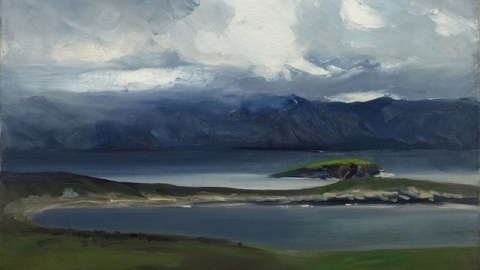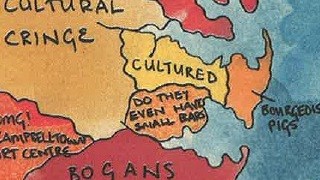How American Artist Robert Henri Found Himself Again in Ireland

The first time you see the name Robert Henri, it’s natural to pronounce it “ahn-ree.” Although the artist was partly of French descent, he preferred “hen-rye,” perhaps as a nod to his English and Irish roots. In the summer of 1913, after the landmark Armory Show introduced European modernism to America, Henri needed to reassess his life and art. Achill Island in County Mayo, Ireland became Henri’s refuge and the people, especially the children, of the little village of Dooagh became his subjects and salvation. In the exhibition From New York to Corrymore: Robert Henri and Ireland at the Mint Museum of Art, the role of Ireland in Henri’s career is finally examined in depth. Henri’s production proves the power of place and the power of ethnic tradition to inspire artists and confirm their inner visions.
“[T]here was only one place outside of New York about which Henri felt strongly enough to purchase a second home, one place away from the city that he found such stimulating subjects that he could return to them repeatedly. That place was Ireland,” writes Jonathan Stuhlman, curator of American art at the Mint Museum of Art, in the catalog to the exhibition. Stuhlman sets up the full context of Henri’s road to Corrymore, including the artistic interaction of The Eight, aka, the Ashcan School, with the Irish immigrants of New York City. In addition to Henri, George Luks, John Sloan, and George Bellows painted sympathetic images of the Irish in America to offset unflattering stereotypes depicted by Thomas Nast, Richard F. Outcault, and others. Henri’s brand of realism, however, came into question when the Armory Show brought Paul Cézanne, Marcel Duchamp, and many others fully into the American artistic consciousness. Faced with that challenge, Henri got back to basics, and back to his Irish roots.
Henri’s resurrected Irishness originated with his meeting Irish painter John Butler Yeats, father of the poet William Butler Yeats and painter Jack B. Yeats, in 1909. Henri thought Yeats was “the greatest British portrait painter of the Victorian era.” “But Yeats was more than a friend and a subject for Henri,” Stuhlman writes. “He was also a conduit to Irish culture.” That interest, which extended to the plays of John Millington Synge, as much as the artistic challenge drove Henri to the emerald isle.
Once on Achill Island, Henri continued to paint landscapes, such as the beautiful West Coast of Ireland (shown above), but portraits of the local villagers occupied most of his time (at least when he wasn’t trout fishing). “The Irish children fascinate me,” Henri said later. “I have always been interested in the Irish anyhow; I have always felt the poet in the Irishman.” Henri’s lyrical portrait style tapped into the poetic innocence of the children of Dooagh as well as the adults. The Mint’s own My Friend Brien by Henri shows 76-year-old mountain guide, Brian O’Malley, with a glimmer in his eye and a tall tale on his lips. When Henri returned every summer from 1924 through 1928, he bonded with the villagers and continued to explore his portraiture. “[Henri’s] late Irish portraits, in which he explored—at the brink of modernism—formal and abstract concerns on his own terms,” Valerie Ann Leeds writes in the catalog, “are his final artistic statement… in which his staunch dedication to formalism and a modified brand of realism are still abundantly evident.” Only Henri’s death in 1929 ended his extended love affair with the Irish.
Even a century later, Ireland can inspire a painter to stretch creatively. The documentary film Ballycastle, by Shirley Road Productions, followed the Philadelphia-based artist Stuart Shils on his travels in Ballycastle in County Mayo. Invited by the Ballinglen Arts Foundation, which financially supports artists willing to come to Ballycastle to paint, Shils fell in love with the Irish landscape and the Irish people. “I never knew a place like this,” Shils says in the film. “This is total madness.” That “madness,” specifically, is the intoxicating thrill of discovering the ever-changing, ever-challenging Irish landscape. Shils draws apt parallels between the Irish and his own Jewish ancestry in a common immigrant experience and a powerful attachment to the land. Ballycastle is the perfect accompaniment to From New York to Corrymore: Robert Henri and Ireland in that it places you cinematically right there where Henri walked and worked, albeit a century later but still among the timeless qualities that both artists experienced.
Henri’s “Irish portraits emerge as arguably the body of work in which he most consistently achieved his own goals” of realism and freedom, Stuhlman argues. A quintessentially American artist, Henri is also quintessentially Irish in his warmth, humor, and humanity. From New York to Corrymore: Robert Henri and Irelandremindsus that being from somewhere else is part of being an American, and that returning to one’s roots can also be a return to native beliefs. Just like everyone is Irish on Saint Patrick’s Day, everyone is Irish when you look at the portraits of Robert Henri.
[Image:Robert Henri. West Coast of Ireland, 1913. Oil on canvas, 26 x 32 inches. Everson Museum of Art; Museum purchase, 58.6.]
[Many thanks to the Mint Museum of Art for providing me with the image above and press materials for the exhibition From New York to Corrymore: Robert Henri and Ireland, which runs through August 7, 2011. Many thanks to the University of Washington Press for providing me with a review copy of From New York to Corrymore: Robert Henri and Ireland by Jonathan Stuhlman and Valerie Ann Leeds. Many thanks to Shirley Road Productions for providing a review copy of Ballycastle.]





